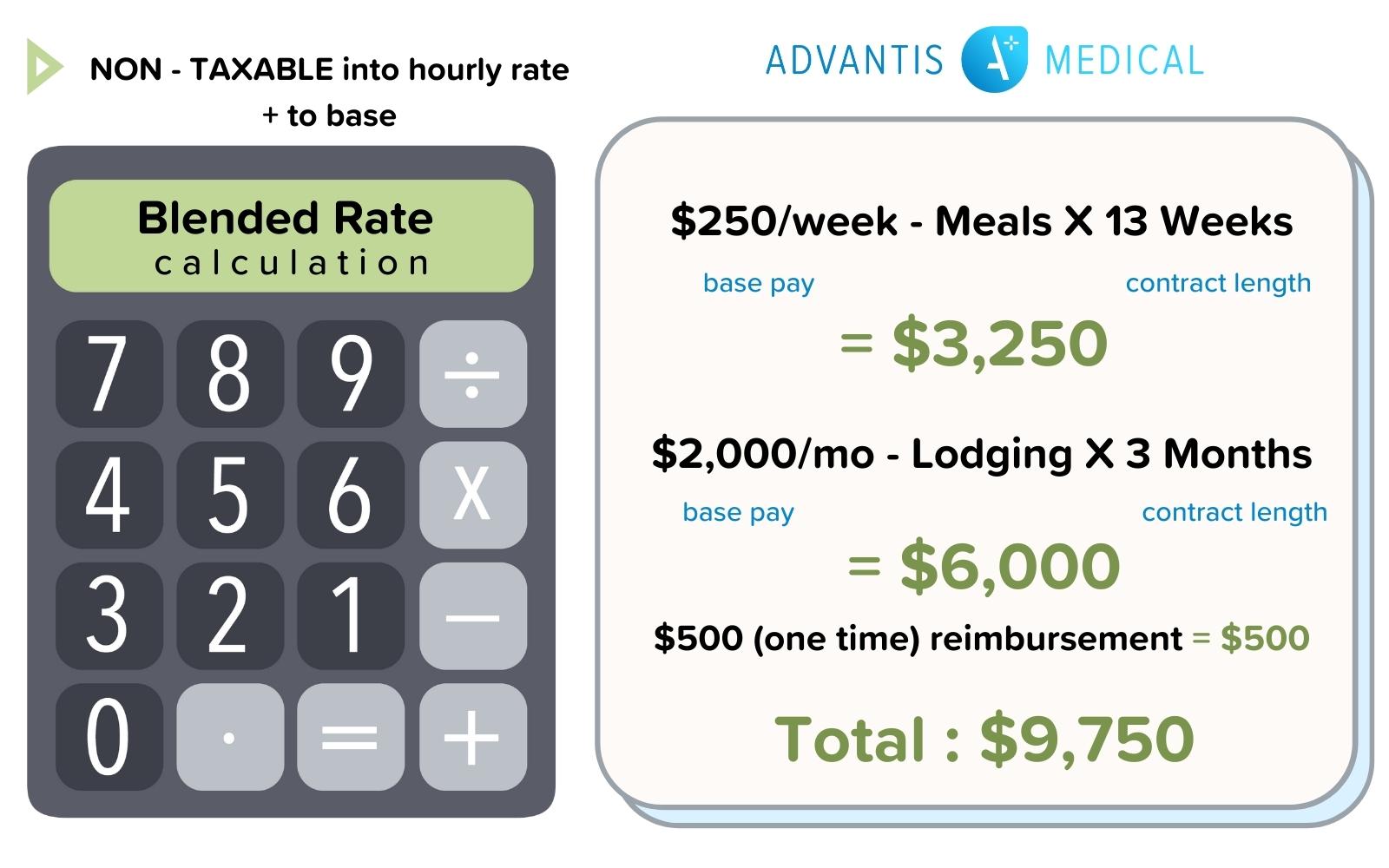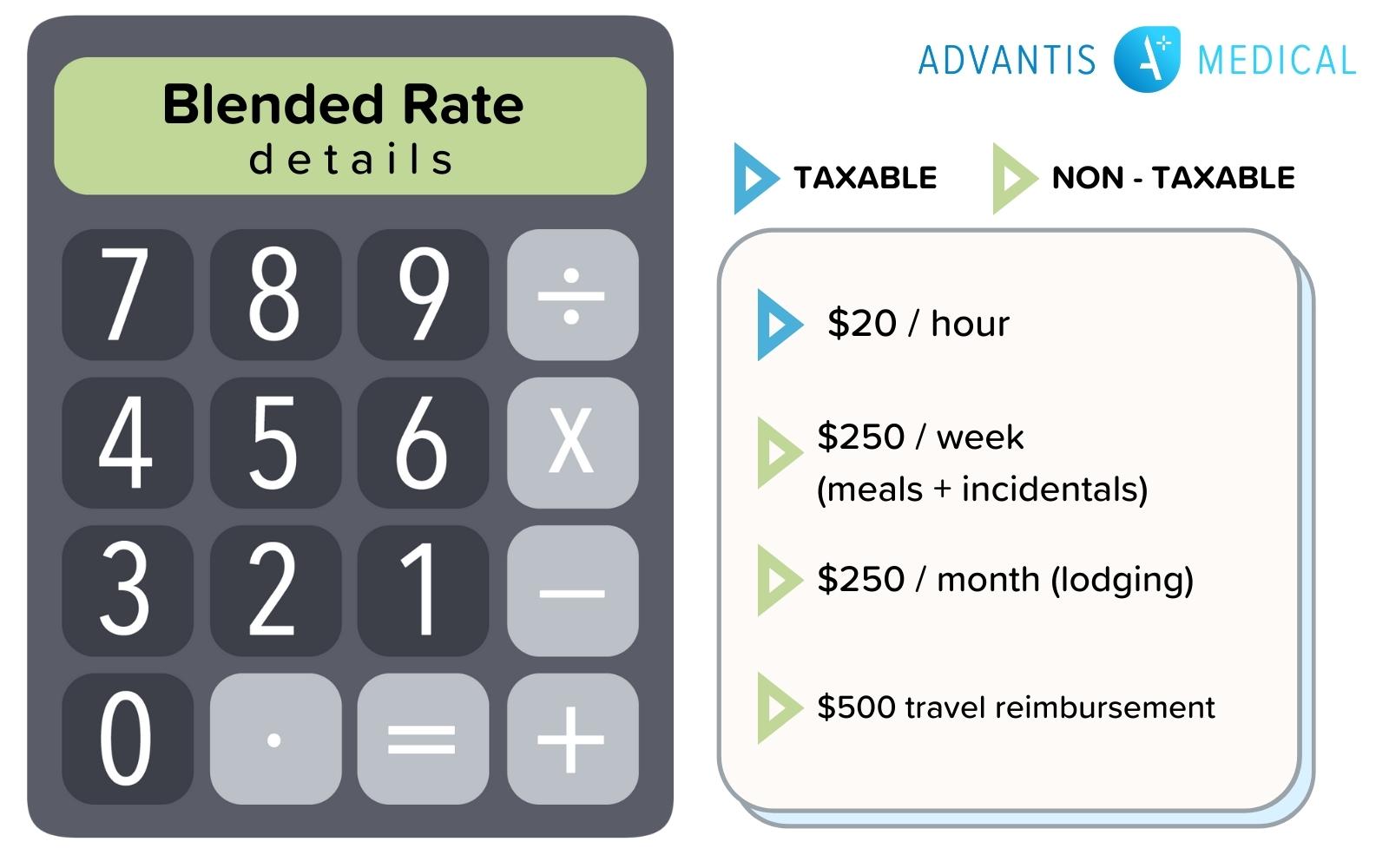Navigating taxes after working Travel nurse jobs can often feel like unraveling a complex puzzle. With a myriad of factors at play that don’t typically apply to standard nursing roles, understanding the full scope of your potential earnings as a travel nurse requires a closer look. This guide is crafted to demystify the components of travel nurse pay packages, aiming to arm you with the knowledge needed to grasp the nuances of your take-home pay comprehensively.
Advantis Medical Staffing offers an integrated nurse pay calculator so that you don’t have to figure out what you can expect to make manually. Plus, we care about our travelers and want to be as open and honest about compensation as possible. We are here to be your travel companions. Also check out our detailed guide on how much do travel nurses make.
Tax Advantage Plan
When it comes to advertising, one of the most enticing features that many travel nurse agencies use to get you in the door is the “tax advantage plan.” This may also be referred to as per-diem, reimbursements, stipends, or a combination of the three. This means that if you are traveling away from your home for work, you will have some tax-deductible expenses and some reimbursements that will be non-taxable.
In the world of travel nursing, the most common reimbursements or stipends you’ll hear about are meals/incidentals, lodging/housing stipends, travel reimbursements that cover expenses to/from each assignment. Other non-taxable items include health insurance, retirement plans, and license reimbursement.
When an agency advertises their pay rate, they often give you a blended rate. This combines your hourly rate and your non-taxable reimbursements/stipends to give you a higher hourly rate. Here’s an example:

- $20/hour (taxable base reported to IRS)
- $250/week meals/incidentals (non-taxable)
- $2,000/month lodging (non-taxable)
- $500 travel reimbursement (non-taxable)
You can find the blended rate by breaking down the non-taxable stipends into an hourly rate and adding it to your base. For example, if you are working 36 hours/week on a 13-week assignment, your hourly rate would look like this:

- $250/week- meals x 13 weeks $3,250
- $2,000/month – lodging x 3 months $6,000
- $500 one-time travel reimbursement $500
- Grand total = $9,750
Now, you’ll divide this total by the total number of hours you worked:
$9,750/468 hours
Your non-taxable stipend pay is $20.83/hour.
When you add that to your original base pay of $20/hour to calculate combined hourly travel nurse pay, you end up with $40.83/hour.
Rigid Pay vs. Flex Pay Packages
When it comes to travel nurse compensation packages, there are two different types: rigid pay and flex pay.
A rigid pay compensation package is non-negotiable. What you are quoted is what you get, and the only options you have are to accept it or decline it.
On the other hand, a flex pay compensation package allows you to mix/match components and add/subtract stipends, including license reimbursements, retirement, healthcare, and more.
The benefit of the flex pay package is that you can decrease your taxable base rate and increase non-taxable income by adding benefits such as a 401K.
How Does Travel Nurse Overtime Work?
You may have some contracts that will offer the option of overtime. For example, they’ll ask you if you’d like to work 4 days instead of 3. By law, overtime has to be paid at a rate of 1.5 times your base rate.
Keeping in line with our example above, if your base hourly rate is $20, your overtime rate would be $30. While this may not sound like a lot for one shift, it does add up over the long run.
Therefore, if you’re considering agreeing to work overtime, make sure to negotiate a higher tax rate or lower non-taxable stipends so that you get more bang for your buck.
Non-Taxable Stipend Pay Disadvantages
You may find that having low taxable income and high non-taxable income is enticing- but there are some disadvantages to this situation. We’ll take a look at some of these disadvantages below.
First, it’s a disadvantage if you’re trying to get a loan. When it comes to approving loans, most banks don’t look at stipends/reimbursements. Therefore, if you’re trying to get a loan, you may appear to have only earned $30,000 in one year when you earned $60,000.
Another issue that may come up is related to retirement. You might be young enough that retirement is way out on the horizon, and your social security check is not a top priority at the moment. However, it’s essential to remember that your social security payments are based on your income-earning years, and non-taxable income is not considered income.
Finally, if you are injured on the job, you will only be paid 2/3 of the taxable portion of your hourly rate.
These are just some of the things you’ll want to keep in mind when considering travel nurse compensation packages.
Things to Consider about Travel Nurse Pay
As you can see, when it comes to compensation, the pay rate of a travel nurse is quite similar to that of a staff nurse. However, there are some factors that a travel nurse needs to keep in mind that a staff nurse doesn’t have to think about:
- Most travel nurse agencies don’t offer PTO. If you plan to take a vacation or take time off between assignments, you will not be paid for that time.
- Most of the time, travel nurses are responsible for their certifications, including ACLS and BLS.
- Some agencies don’t pay for your annual TB test and physical.
- If you accept an assignment across the country, the travel reimbursement may not cover the whole trip- you may end up having to come out of pocket on some things.
Travel nursing is just like other professions. You must make sure to budget and prepare for the worst. Make sure that you are taking care of yourself and keeping yourself organized.
IRS “Tax Home Explained
Of course, to qualify for non-taxable stipends/reimbursements, you must have what the IRS refers to as a “tax home”. This is a place of residence that you maintain/pay for when you’re out on assignment. The IRS would prefer that a travel nurse take an assignment somewhere and return to their tax home and maintain a PRN or full-time nursing position.
Most agencies will have you sign a statement that you have a tax home. If you don’t plan to maintain a residence when traveling, you’ll be labeled as an itinerant worker. This means that you’ll have to pay taxes on all income received, including stipends/reimbursements. When you are applying with travel nurse agencies, make sure they know your status.
Quick Travel Nurse Tax Tips
Talking about income, taxes, and the IRS may be a bit scary. However, there are some things you can do to keep this experience from being so complicated.
- Keep track of your mileage. On January 1, write down your odometer reading. At the end of the year, on December 31, re-record it. If you are starting in the middle of the year, check maintenance records to find the appropriate odometer reading.
- If possible, you should return to your tax home between your travel assignments- but if that’s not possible, at least return once a year.
- Make sure you have a PRN or agency job within the vicinity of your tax home. The IRS wants to know that you’re doing business in the area where you live.
- You don’t have to worry about keeping track of your grocery/meal receipts because the IRS has a set stipend for meals. If you exceed this, it’s considered living above your means, and you won’t get reimbursed.
- Ensure that you keep copies of all of your contracts that clearly state the beginning and ending dates. This will be proof that you’re working on a temp basis.
- Never work more than 12 months in 24 months on a travel assignment. If you do, the IRS will assume you abandoned your tax home.
- Find a tax professional that specializes in travel nursing.
Make Traveling a Breeze with Advantis Medical Staffing
Advantis Medical Staffing cares deeply about its employees and strives to be transparent with its compensation packages. You can take advantage of the travel nurse pay calculator on AdvantisConnect to help you determine your take-home pay.









